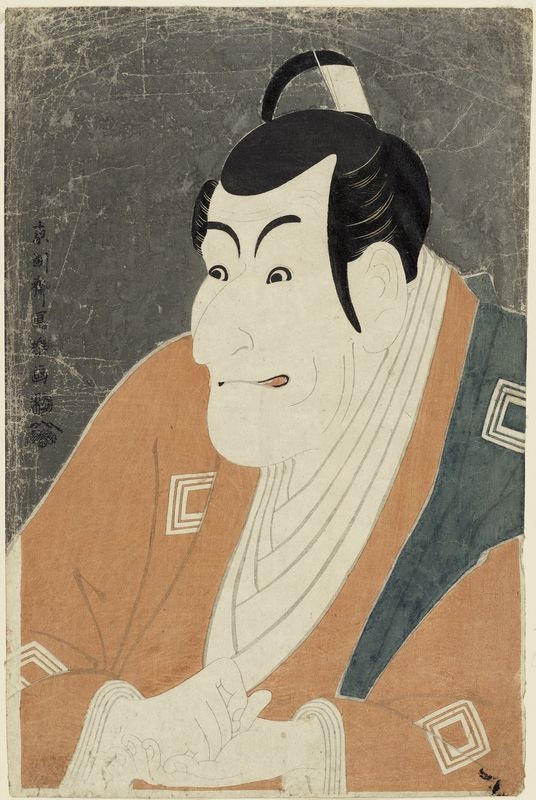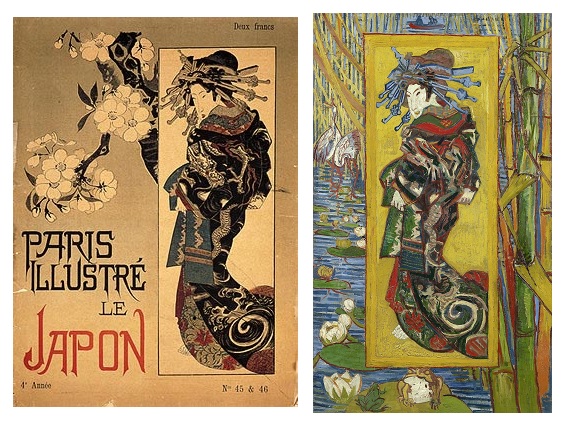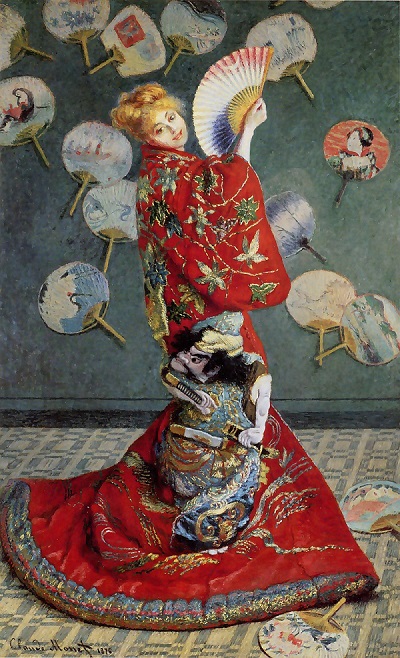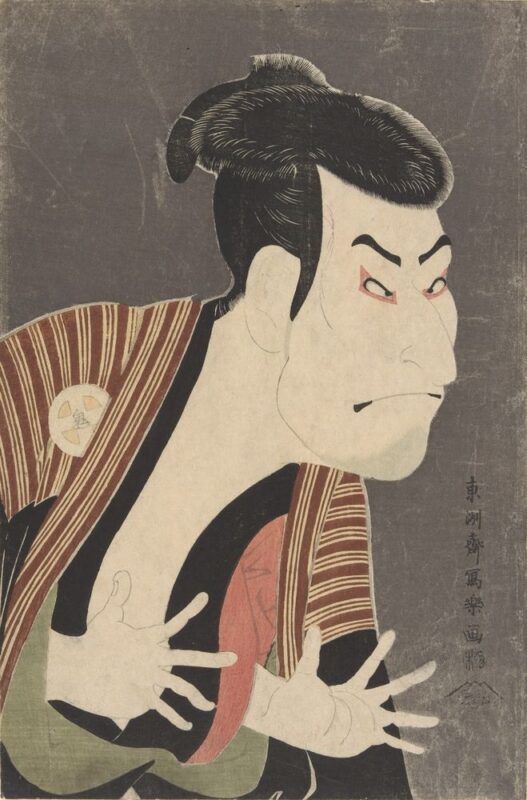Ukiyo-e is now recognized worldwide as one of Japan’s most iconic art forms. Among them, Katsushika Hokusai’s The Great Wave off Kanagawa from Thirty-Six Views of Mount Fuji is often considered one of the most famous paintings in the world, second only to Leonardo da Vinci’s Mona Lisa.
In this article, we introduce 10 must-see masterpieces of ukiyo-e, perfect for beginners who want to dive deeper into its charm. Through these works, why not explore the beauty and history of Japan’s traditional art?
10 Masterpieces of Ukiyo-e

Source: Wikipedia
What is Ukiyo-e?
Ukiyo-e is a genre of woodblock prints and paintings that flourished in Japan during the Edo period (17th–19th century). These artworks depicted everyday life, beautiful landscapes, kabuki actors, and charming women (bijin-ga). Ukiyo-e is known for its vibrant colors, unique compositions, and lively portrayal of Edo-period life.
Early ukiyo-e mainly featured portraits of actors and beautiful women, but over time, landscape prints, samurai warriors, and scenes of common people’s lives also became popular. These prints were mass-produced and affordable, making them accessible to the public. Later, ukiyo-e greatly influenced European artists, contributing to the Japonisme movement that shaped Western art.
How Ukiyo-e Prints Were Made
Ukiyo-e prints were produced through a unique division of labor, involving multiple artisans:
- Artist (Eshi): Creates the original design.
- Carver (Hori-shi): Engraves the design onto wooden blocks.
- Printer (Suri-shi): Prints the design onto paper using ink and blocks.
- Publisher (Han-moto): Oversees planning and distribution.
This system ensured highly detailed and vividly colored prints. In the 19th century, ukiyo-e spread to Europe, influencing artists like Vincent van Gogh and Claude Monet. This impact, known as Japonisme, played a key role in shaping modern Western art.
The Four Main Genres of Ukiyo-e
Ukiyo-e can be broadly categorized into four main genres: Bijin-ga (beauty portraits), Yakusha-e (actor prints), Musha-e (warrior prints), and Fūkeiga (landscape prints). Let’s take a closer look at each.
1. Bijin-ga (Beauty Prints)
.jpg)
Source: Wikipedia
- Famous Work: A Girl Blowing a Glass Toy (Poppen o Fuku Musume) by Kitagawa Utamaro
- Collection: The Metropolitan Museum of Art
- Source: Met Museum
Bijin-ga depicts elegant women in refined poses, showcasing graceful gestures, luxurious clothing, and delicate facial expressions. These prints reflect women’s lifestyles and fashion trends of the Edo period, making them valuable cultural records.
2. Yakusha-e (Actor Prints)

- Famous Work: Ichikawa Ebizō as Takemura Sadanoshin by Tōshūsai Sharaku
- Collection: Tokyo Fuji Art Museum
- Source: Tokyo Fuji Art Museum
These prints capture the dramatic expressions and exaggerated poses of kabuki actors, making them highly popular among theater fans. Mass production allowed audiences to collect portraits of their favorite actors.
3. Musha-e (Warrior Prints)

- Famous Work: Brave Warrior Hara Hayato-no-kami from One Hundred Warriors of the Battle of Kawanakajima by Utagawa Kuniyoshi
- Collection: Tokyo Fuji Art Museum
- Source: Tokyo Fuji Art Museum
Musha-e depicts historical warriors and legendary samurai in dynamic battle scenes. These prints often feature vibrant colors and bold compositions, bringing heroic tales to life.
4. Fūkeiga (Landscape Prints)

- Famous Work: Ejiri in Suruga Province from Thirty-Six Views of Mount Fuji by Katsushika Hokusai
- Collection: Tokyo Fuji Art Museum
- Source: Tokyo Fuji Art Museum
Landscape prints capture Japan’s scenic beauty, often highlighting famous landmarks and natural wonders. Hokusai’s Thirty-Six Views of Mount Fuji and Utagawa Hiroshige’s The Fifty-Three Stations of the Tōkaidō are among the most celebrated works. These prints offered Edo-period audiences a way to experience travel and nature from the comfort of their homes.
・・・🔷・・・
These four genres showcase the rich diversity of ukiyo-e, each offering a unique glimpse into Edo-period society and culture. Today, they remain invaluable cultural treasures that continue to inspire art lovers worldwide.
Why Is Ukiyo-e Highly Regarded Worldwide?

(Right) Vincent van Gogh, Japonaiserie: Oiran
Source: Wikipedia
In the 19th century, ukiyo-e made its way from Japan to Europe, sparking a fascination with Japanese culture known as Japonisme. This movement had a profound influence, particularly in France, where artists like Vincent van Gogh and Claude Monet were inspired by ukiyo-e, broadening the possibilities of artistic expression. But what made ukiyo-e so captivating to Western audiences?
1. Freedom of Subject Matter
European paintings of the 19th century primarily depicted religious and historical themes, adhering to strict artistic conventions. In contrast, ukiyo-e freely illustrated everyday life, breathtaking landscapes, kabuki actors, mythical creatures, and even sumo wrestlers.
This fresh perspective was a revelation to Western artists. Many were inspired by the idea that art could depict such diverse themes without constraint, leading to new creative directions.
2. Unique Composition
Ukiyo-e compositions differ from the traditional Western approach to perspective. For example, in The Great Wave off Kanagawa by Katsushika Hokusai, the dramatic, towering wave appears on the verge of engulfing boats, while a small Mount Fuji remains in the background. This unconventional perspective provided a new sense of depth, influencing the development of Impressionism.

Source: Wikipedia
3. Bright and Vibrant Colors
Western paintings often featured rich, deep colors, but ukiyo-e employed lighter, more playful hues, creating a cheerful and accessible aesthetic. Impressionist painters were particularly drawn to these vibrant color schemes and began incorporating them into their own works.
4. The Aesthetic of Negative Space
Unlike Western paintings that often filled every inch of the canvas, ukiyo-e artists embraced ma (negative space) to create simplicity and balance. By leaving areas intentionally empty, they achieved a sense of depth and tranquility. This concept was eye-opening for many Western painters, who adapted this approach into their own compositions.
・・・🔷・・・
With its thematic freedom, innovative compositions, vivid colors, and appreciation of negative space, ukiyo-e introduced fresh perspectives to Western art. Its influence is evident in Impressionism and Post-Impressionism, leaving an indelible mark on the evolution of global artistic expression.
Top 10 Must-See Masterpieces in Ukiyo-e History — Timeless Gems of Japanese Art
Thanks for waiting! Here are 10 masterpieces of ukiyo-e that have left a lasting mark on the history of Japanese art. Each one is explained in a way that’s easy to understand, even for beginners—so let’s enjoy learning together!
1. Katsushika Hokusai — The Great Wave off Kanagawa (from Thirty-six Views of Mount Fuji)

Source: Wikipedia
Edo Period / c. 1831–33 (Tenpō 2–4)
Ōban Nishiki-e (large-format color woodblock print)
Collection: Tokyo Fuji Art Museum(https://www.fujibi.or.jp/collection/artwork/03628/)
When people think of ukiyo-e, this is probably the image that comes to mind. The Great Wave off Kanagawa is one of the most iconic Japanese artworks, known around the world. It shows Mount Fuji seen from offshore near what is now Honmoku in Yokohama. In the West, it's often called The Great Wave, and the massive wave dominating the scene truly lives up to that name.
The wave is thought to be around 10 to 12 meters high—almost like a tsunami in intensity. Its powerful motion and splashing spray captivate the viewer. But there's more to discover here.
Take a closer look, and you’ll see three small boats being swallowed by the giant wave. These are oshiokuri-bune, high-speed boats that once carried fresh fish from nearby fishing ports to Edo. They could be sailed or rowed depending on the situation. In this scene, however, there's no chance of controlling them. You can almost feel the tension and desperation of the crew.
Another reason why this work never gets old is its perfect composition. Try searching for “Hokusai golden ratio” on Google—you'll find that the placement of Mount Fuji and the curves of the wave align beautifully with the golden ratio, a proportion believed to be most pleasing to the human eye. Hokusai’s masterful sense of balance shines through.
This isn’t just a landscape print—it’s a work of art crafted with precision. The powerful wave, the stunning composition, and Mount Fuji towering in the background all come together to create a piece that continues to fascinate people around the world.
2. Tōshūsai Sharaku — The Actor Ōtani Oniji III as Yakko Edobei

Source: Wikipedia
Edo Period / May 1794 (Kansei 6)
Ōban Nishiki-e
Collection: Tokyo National Museum(https://www.tnm.jp/modules/r_collection/index.php?controller=dtl&colid=A10569.471)
If there's an ukiyo-e print that rivals The Great Wave in fame within Japan, it’s this striking portrait by Sharaku. The actor’s intense pose and dramatic expression have been adapted into countless illustrations, parodies, and merchandise—making it a familiar image even today.
The Mysterious Artist Sharaku
Sharaku appeared on the ukiyo-e scene suddenly in May 1794, thanks to the publisher Tsutaya Jūzaburō. His debut work was a series of 28 large-format portraits of kabuki actors.
At the time, Tsutaya had just suffered a major setback—his popular yellow-covered books by Santō Kyōden had been banned, and he lost about half his assets. But he was regaining momentum with Utamaro’s portraits of beautiful women, and in search of his next big hit, he introduced Sharaku to the world.
Among Sharaku’s debut prints, Ōtani Oniji III as Yakko Edobei stands out as the most famous. It captures a scene from the kabuki play Koi Nyōbō Somewake Tazuna, performed at the Kawarazaki Theater. In this moment, the villain Edobei (played by Ōtani Oniji III) tries to steal 300 ryō of public funds along with his accomplice Washizuka Yaheiji.
The way Sharaku portrays Edobei is unforgettable—his sharp eyes, tightly drawn mouth, tensed arms, and exaggerated hands all contribute to an almost lifelike intensity, as if he’s about to jump off the paper.
Sharaku’s actor portraits, with their close-up focus on the face, were unusually realistic for the time. Some critics thought they were too lifelike, and reactions were mixed at first. But today, his bold style is praised as art of the highest quality and treasured by museums and collectors worldwide.
Many of Sharaku’s original 28 prints, including this one, are now held overseas, making it rare to see them all together in Japan. At the recent Great Ukiyo-e Masters exhibition, masterpieces returned from museums around the world and dazzled visitors. The use of a special mica printing technique called kurokirazuri gives the surface a shimmering effect under light—adding even more allure to these dramatic portraits.
3. Katsushika Hokusai — Fine Wind, Clear Morning (from Thirty-six Views of Mount Fuji)

Source: Wikipedia
Edo Period / c. 1831–33 (Tenpō 2–4)
Ōban Nishiki-e
Collection: Tokyo Fuji Art Museum(https://www.fujibi.or.jp/collection/artwork/03769/)
We return to Hokusai with another beloved piece. Known as “Red Fuji,” this work captures a rare natural phenomenon seen only for a few minutes on clear summer or early autumn mornings—when Mount Fuji is bathed in red sunlight. Hokusai's Fine Wind, Clear Morning boldly depicts this breathtaking moment.
Try searching for “Red Fuji” online—you’ll find many photos by amateur and professional photographers alike, showing how this view continues to inspire.
Along with The Great Wave, this is one of the most popular prints in the Thirty-six Views of Mount Fuji series. Despite its simple composition, it has an overwhelming beauty. The word “gai-fū” in the title means “southern wind,” and beneath streaks of wispy clouds, the majestic Mount Fuji spreads out in glowing reds, blues, and greens.
There’s also a rare version known as “Blue Fuji,” which caused a stir when exhibited at the Sumida Hokusai Museum in 2019. Featuring a striking blue Mount Fuji, it’s a favorite among Hokusai fans.
4. Utagawa Hiroshige — Night Snow at Kambara (from The Fifty-three Stations of the Tōkaidō)

Source: Tokyo Fuji Art Museum
Edo Period / c. 1834–36 (Tenpō 5–7)
Ōban Nishiki-e
Collection: Tokyo Fuji Art Museum(https://www.fujibi.or.jp/collection/artwork/04336/)
Alongside Hokusai, Utagawa Hiroshige was one of the great landscape artists of the late Edo period. His series The Fifty-three Stations of the Tōkaidō was a huge success, much like Hokusai’s Thirty-six Views of Mount Fuji. Before that, landscapes were mostly just backgrounds for portraits—but Hiroshige helped turn scenic views into a genre of their own.
One especially poetic work in the series is Night Snow at Kambara. If you’ve been to Kambara (now part of Shimizu Ward in Shizuoka), you might know it rarely snows there. Even in bad weather, it’s more likely to rain than snow.
But Hiroshige chose to depict a quiet, snowy night, creating a dreamlike atmosphere. In the muted gray landscape, the travelers stand out just slightly in color. This peaceful, emotional scene is a true showcase of Hiroshige’s artistic style.
5. Utagawa Hiroshige — Shōno: Sudden Shower (from The Fifty-three Stations of the Tōkaidō)

Source: Tokyo Fuji Art Museum
Edo Period / c. 1834–36 (Tenpō 5–7)
Ōban Nishiki-e
Collection: Tokyo Fuji Art Museum(https://www.fujibi.or.jp/collection/artwork/04366/)
Among the many weather-themed pieces in The Fifty-three Stations of the Tōkaidō, Shōno: Sudden Shower is one of the most popular. The title’s “haku-u” means “evening shower.” The print captures a sudden downpour, with rain slashing straight down against a steep slope.
Travelers scramble to cover themselves with rain gear, hurrying along the slippery road. One man looks like he might slip at any moment. Each person’s outfit is different—showing Hiroshige’s careful attention to detail.
Another highlight is the way the rain is depicted. Unlike Western paintings, Hiroshige used black lines to draw the rain itself, emphasizing the storm’s intensity. You can almost hear the downpour as you look at it—an immersive and dramatic scene that’s worth a closer look.
・・・🔷・・・
To be continued in Part 2…
▶世絵の名作10選!世界で評価された日本のアートとは?(後編)